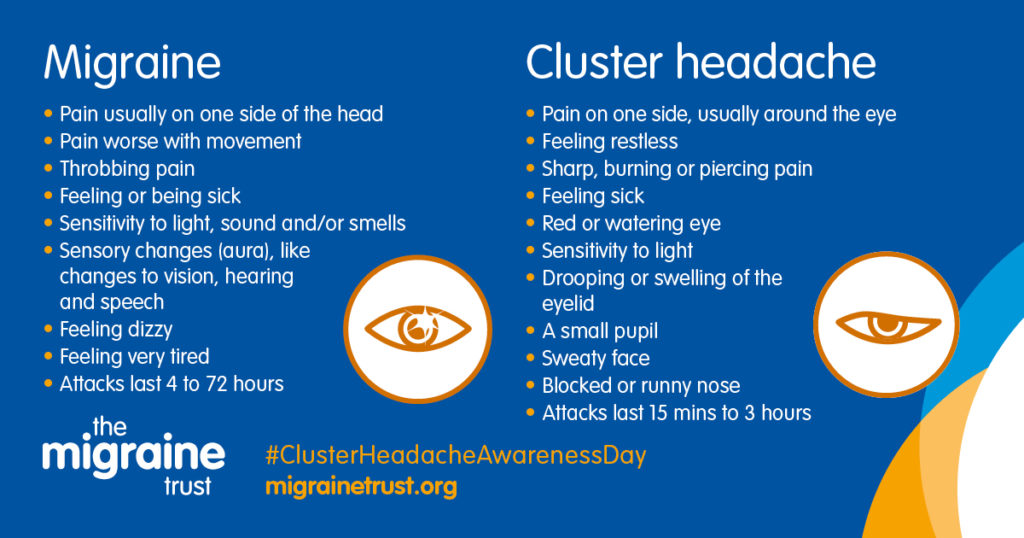Cluster headache vs migraine
By: Rachel Baxter, Communications Officer, The Migraine Trust
In this blog, we answer commonly asked questions about cluster headache and migraine. For general information on what cluster headache is, diagnosis and treatment, take a look at our cluster headache information page here.
Is a cluster headache a kind of migraine attack?
Cluster headache is its own condition and not the same as migraine. Cluster headache and migraine are both primary headache disorders. This means that the symptoms they cause are a result of the headache condition itself, rather than another underlying problem. Some of the symptoms of cluster headache and migraine overlap, which is why it’s easy to confuse the two.
What’s the difference between migraine and cluster headache?
Who gets them
Cluster headache is much rarer than migraine, and only about one in 1,000 people have it. Meanwhile, we know that migraine is very common and affects one in seven people.
Cluster headache tends to start when people are in their 30s and 40s, although it can affect people at any age. Migraine can also begin at any age, but many people experience their first attack during adolescence.
Migraine is more common in women than men, while the opposite is true for cluster headache.
The symptoms
Although migraine and cluster headache can both cause severe headache, the nature of these headaches is quite different. A migraine headache tends to be a throbbing or pulsating pain that often happens on one side of the head. A cluster headache can come on very quickly and the pain is often described as sharp, piercing or burning in nature. It also occurs on one side of the head but the pain tends to be focused around or behind one eye.
As anyone with migraine knows, headache is not the only symptom – other migraine symptoms include nausea and vomiting, fatigue, dizziness, sensitivity to light, sounds and smells, and changes to your vision, hearing or speech (known as migraine aura).
A cluster headache attack, meanwhile, comes with its own range of symptoms. These include a red or watering eye, a smaller pupil in the affected eye, drooping or swelling of the eyelid, a sweaty face, and a blocked or runny nose.
Some people with migraine might experience temporary weakness on one side of their face, particularly if they have hemiplegic migraine, and a blocked or runny nose is sometimes reported as a migraine symptom too, so there can be a bit of overlap between the two conditions. Nausea and sensitivity to light can also happen during a cluster headache, as can aura although this is rare.
It should be possible for your doctor to make an accurate diagnosis based on your symptoms.

How long they last
Migraine and cluster headache tend to differ in how long an attack lasts. Migraine attacks usually last between four hours and three days, while cluster headaches generally last between 15 minutes and three hours. Cluster headaches often stop very suddenly, while many people find their migraine attacks slowly ease away. It’s possible to have up to eight cluster headache attacks in a day.
How often they happen
Like migraine, cluster headache can be either episodic or chronic. This means that some people experience a cluster headache every now and then, while others might have attacks on most days.
Cluster headaches normally happen in bouts or clusters, hence the name. This means that people with the condition go through cycles of having an intense period of more frequent cluster headaches that can last from weeks to months, followed by a remission period where they might not have a headache for months at a time.
Can you have migraine and cluster headache together?
It is possible to be diagnosed with both migraine and cluster headache, and research suggests that around 10 to 17 percent of people with cluster headache also have migraine (about 14 percent of the general population have migraine). A 2019 study found that chronic cluster headache appears to be slightly more common in people who also have migraine.
The exact causes of migraine and cluster headache are still unknown. We know that both have a genetic component, but a 2018 review of the literature notes that the way they’re inherited is likely to be different and whether there are some shared genetic traits between the two disorders is unclear. A more recent study of cluster headache genes conducted last year found that a small amount of the genetic susceptibility for cluster headache overlaps with susceptibility for migraine and other headache disorders, but a larger component is specific to just cluster headache.
Cluster headache and migraine respond to some of the same treatments, such as triptans, but further research is needed to find out more about the two conditions and whether they are linked in any way.
You can read about Taiyeba’s experience of living with chronic migraine and cluster headache here. For more on cluster headache, visit the Organisation for the Understanding of Cluster Headache (OUCH).


